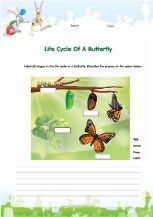Life Cycle of a Butterfly Lesson Plan Pdf
Worksheet on the life cycle of a butterfly - Pdf. Print here >>>
 Butterflies are fascinating creatures that undergo a remarkable transformation throughout their life cycle. Understanding this cycle not only enriches our knowledge of nature but also provides valuable learning opportunities for students of all ages.
Butterflies are fascinating creatures that undergo a remarkable transformation throughout their life cycle. Understanding this cycle not only enriches our knowledge of nature but also provides valuable learning opportunities for students of all ages.
Importance of Teaching About Butterflies
Teaching about butterflies goes beyond just biology. It instills curiosity, respect for nature, and an understanding of interconnectedness. Moreover, it encourages environmental stewardship and promotes scientific inquiry.
Understanding the Stages of a Butterfly's Life Cycle
Egg Stage
The journey of a butterfly begins with the laying of eggs. These tiny, often overlooked structures hold the potential for new life. Exploring the egg stage introduces students to the concept of life starting small.
Larva Stage
After hatching, the larva, commonly known as a caterpillar, emerges. This stage is characterized by rapid growth as the caterpillar feeds voraciously on plant matter. It's an excellent opportunity to discuss the importance of adaptation and survival.
Pupa Stage
During the pupa stage, the caterpillar undergoes a dramatic transformation inside the chrysalis. This metamorphosis captures the imagination and teaches patience and perseverance as students wait for the butterfly to emerge.
Adult Butterfly Stage
The emergence of the butterfly marks the culmination of its journey. This stage showcases the beauty of nature's designs and highlights the role of butterflies in pollination and ecosystem health.
Designing a Lesson Plan for Teaching the Life Cycle of a Butterfly
Creating an effective lesson plan requires careful consideration of objectives, materials, activities, and assessment strategies.
Setting Objectives
Clearly define what students should learn about the butterfly life cycle, ensuring alignment with educational standards and learning goals.
Selecting Materials
Gather a variety of resources, including books, videos, and visual aids, to cater to different learning styles and preferences.
Engaging Activities
Design interactive activities such as role-plays, experiments, and art projects to keep students actively involved and excited about learning.
Assessment Strategies
Assess student understanding through quizzes, discussions, and hands-on demonstrations to gauge learning outcomes effectively.
Incorporating the Lesson Plan into Different Educational Settings
Whether in a traditional classroom, outdoor environment, or virtual setting, adapting the lesson plan ensures accessibility and inclusivity.
Classroom Teaching
Utilize the school environment and resources to create immersive learning experiences that captivate students' attention.
Outdoor Learning
Take advantage of nature trails, gardens, and parks to observe butterflies in their natural habitat and reinforce learning through firsthand experiences.
Virtual Learning
Incorporate digital tools and virtual simulations to simulate butterfly encounters and facilitate remote learning opportunities.
Benefits of Using PDF Format for Lesson Plans
PDF format offers several advantages, including compatibility, accessibility, and ease of sharing and printing.
Creating a Comprehensive Butterfly Lesson Plan PDF
Compile all components of the lesson plan into a well-organized PDF document, complete with visuals and supplementary materials.
Tips for Enhancing the Effectiveness of the Lesson Plan
- Tailor activities to the age and interests of the students.
- Encourage exploration and inquiry through open-ended questions.
- Foster collaboration and peer learning opportunities.
- Provide opportunities for reflection and feedback to promote deeper understanding.
Examples of Activities and Resources for Each Stage of the Butterfly's Life Cycle
- Egg Stage: Egg observation diary, egg carton caterpillar craft.
- Larva Stage: Caterpillar anatomy dissection, butterfly life cycle board game.
- Pupa Stage: Chrysalis observation station, butterfly-themed storytelling session.
- Adult Butterfly Stage: Butterfly garden planting project, butterfly identification field trip.
Addressing Common Challenges in Teaching About Butterflies
Overcoming obstacles such as limited resources, time constraints, and student disengagement requires creativity, flexibility, and collaboration.
Conclusion
Teaching the life cycle of a butterfly is not just about imparting scientific knowledge; it's about nurturing curiosity, fostering a sense of wonder, and inspiring a lifelong appreciation for the natural world. By designing comprehensive lesson plans and incorporating diverse teaching strategies, educators can empower students to become enthusiastic learners and responsible stewards of the environment.
FAQs
-
Why is it important to teach about the life cycle of a butterfly?
Understanding the butterfly life cycle promotes scientific literacy, environmental awareness, and empathy for living creatures.
-
How can I adapt the lesson plan for different grade levels?
Modify activities, vocabulary, and complexity to suit the developmental stages and interests of students at various grade levels.
-
What resources are available for teaching about butterflies?
There are numerous books, websites, educational videos, and hands-on kits specifically designed for teaching about butterflies.
-
What are some common misconceptions about butterflies?
One common misconception is that all butterflies are brightly colored; however, some species are more subdued in appearance.
-
How can I encourage outdoor exploration in teaching about butterflies?
Plan field trips to butterfly gardens, nature reserves, or local parks to observe butterflies in their natural habitat and engage in outdoor activities related to their life cycle.

